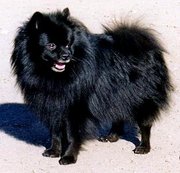
|
From Wikipedia the free encyclopedia, by MultiMedia |
| German Spitz | ||
|---|---|---|

Creme Kleinspitz
|
||
| Alternative names | ||
| Deutscher Spitz | ||
| Country of origin | ||
| Germany | ||
| Common nicknames | ||
| Classification and breed standards | ||
| FCI: | Group 5 Section 4 #97 | |
| AKC: | FSS | |
| ANKC: | Group 7 (Non Sporting) | |
| KC (UK): | Utility (Non Sporting) | |
| NZKC: | Non-Sporting | |
| Not recognized by any major kennel club | ||
| This breed of dog is extinct | ||
| Notes | ||
The German Spitz is a dog breed or group of dog breeds of the Spitz type.
There are five different types of German Spitz:
Most kennel clubs recognise only the Klein and Mittel varieties of German Spitz and consider the Pomeranian (Zwerspitz) and Keeshond (Wolfspitz) as separate breeds. In many countries the Miniature (Klein) spitz is also confused with the Pomeranians (Zwers).
German Spitz are similar in appearance but vary in color. The Giant Spitz can only be black, white, or brown but the Standard, Small and Dwarf can have various color combinations as well.[2]. All German Spitz have a fox like head, double coat, highset triangular ears and a tail that curls up and rests on top of the body. Although the Small Spitz and the Pomeranian look alike they are not the same dog.
German Spitz are descendants of the ancient spitzes found in the Stone Age and they are the oldest breed of dog in Central Europe. [3]
 black German Spitz
black German Spitz
Dogs, made by MultiMedia | Free content and software
This guide is licensed under the GNU Free Documentation License. It uses material from the Wikipedia.